North America is filled with many wonderful birds with red feet – in fact, there are 14 birds that you can spot with red feet. Have you spotted a bird with red feet that you’re looking to identify? Look no further than this article.
This list will list all 14 birds and help birdwatchers find and identify all birds of North America that have red feet with both pictures and calls.
1. Northern Cardinal
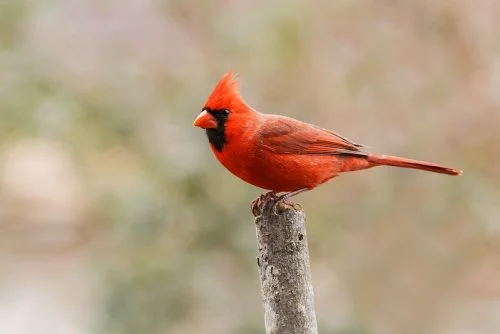
The northern cardinal is a little songbird that is red in color and can be found living in gardens, backyards, and wooded areas.
Cardinals have lengths ranging from 7 to 9 inches, including their long tails.
They are easily identifiable by the lofty, pointed crest of feathers that sits atop their heads, as well as their orange beaks that are fashioned like cones. Males are easily identified in flight by their brilliant red color.
Up to 90 percent of a northern cardinal’s diet can be made up of various types of weed seeds, grains, and fruits.
This animal is a ground feeder that forages among bushes and trees. It also eats snails and a variety of insects, such as beetles, cicadas, and grasshoppers, which are the primary food source for its young.
Many states have adopted the cardinal as their official bird. These birds are named after Catholic cardinals, who wear bright red robes.
To learn more about the Northern Cardinal you can visit: https://www.audubon.org/field-guide/bird/northern-cardinal
2. Red-footed Booby
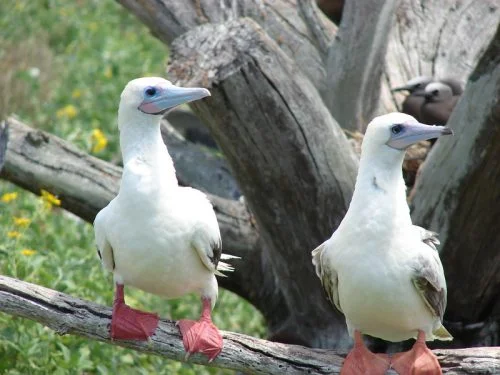
A big seabird belonging to the booby family, Sulidae, the red-footed booby is easily recognizable by its bright red feet. Adults, as the name implies, usually have red feet, but the rest of their plumage is a wide range of colors, typically shades of gray and white. They can fly quickly and deftly, but they are awkward when it comes to taking off and landing.
Red-footed Boobies prey on fish and squid, which they hunt by flying slowly over the ocean. Once they discover prey, they immediately plunge-dive to capture them with the bill, frequently submerging themselves entirely. Although it is smaller and more agile than larger boobies, this species nevertheless captures the majority of its food without having to dive for it.
This long-winged seabird lives in tropical oceans all over the world but only occasionally comes to North America. Most of the time this species has been seen, it has been in the Dry Tortugas area of Florida, but it has also been seen in the waters off the coast of California.
To learn more about the Red-footed Boobies you can visit: https://www.audubon.org/field-guide/bird/red-footed-booby
3. Red-footed Falcon
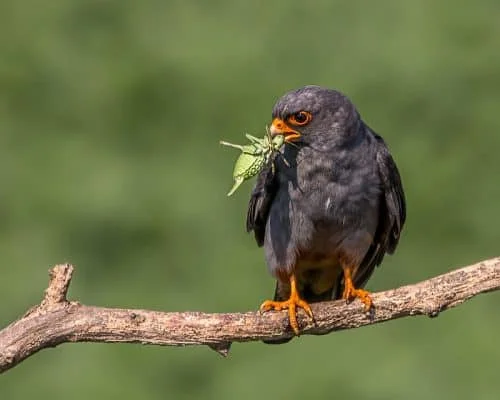
The red-footed falcon, formerly the western red-footed falcon, is a bird of prey. It belongs to the family Falconidae, the falcons.
It has large wings for a bird of its size. The length of a red-footed fawn is 28–34 centimeters, while the width of its wings is 65–75 centimeters.
There is no red on the adult male’s body, save for his undertail and legs; he is a uniform blue-grey otherwise. The female is recognized by her grey upper body and grey wings, orange crown and underparts, and white face with a black eye stripe and black mustache.
The red-footed falcon is a bird of prey with a diet consisting of a variety of insects, amphibians, reptiles, mammals, and birds, such as great green bush crickets, spadefoot toads, sand lizards, the common vole, and bird nestlings, respectively.
The Red-footed Falcon’s breeding area includes much of Asia and Europe, as well as the easternmost parts of Central Siberia. All of the birds that breed in Siberia spend the winter in southern Africa, so they have to travel a long way to get there.
4. Roseate Spoonbill
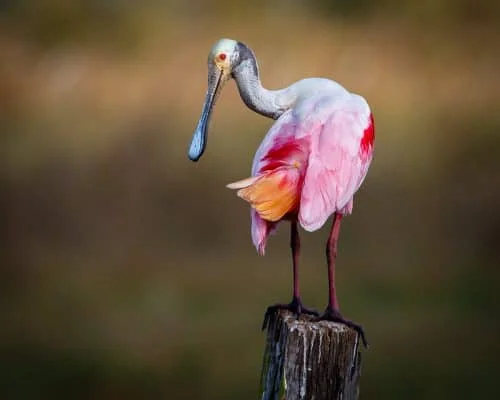
The roseate spoonbill is a big wading bird known for its pink plumage and unusual spoon-shaped bill. The wings and feathers beneath its white upper back and neck are a more distinctive bright pink. The legs and irises of the eyes are also a deep red, as are the wing coverts and tail coverts.
The spoonbill has a distinctive yellow-green color on its head. The birds have a drabber appearance when they are young, but they lighten up as they get older.
The roseate spoonbill typically eats minnows, small crustaceans, insects, and parts of plants, which it catches with its spoon-like bill from shallow water.
They do most of their foraging in the hours just after sunrise and just before sunset in freshwater and saltwater wetlands, respectively.
The roseate spoonbill is native to the coastal regions of southern Florida, Texas, and southwestern Louisiana in the United States.
Roseate spoonbills prefer wet habitats, such as mangroves and marshes, to nest in.
In captivity, they can reach the age of 15 years, although their natural lifespan is only about 10 years.
To learn more about the Roseate Spoonbill you can visit: https://www.audubon.org/field-guide/bird/indigo-bunting
5. American White Ibis
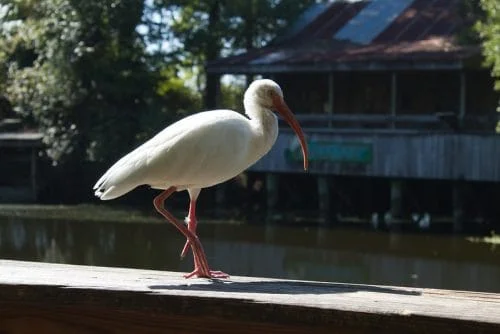
The American white ibis is a medium-sized wading bird distinguished by its pure white feathers and rosy face skin. Unless you’re looking up at an adult bird in flight, you might not notice that it has black wingtips. These birds have a large, downcurved bill and brilliant red-orange legs when they are not breeding.
People say that American white ibises are friendly, but they are also very protective of their nests and breeding grounds.
White ibises in the United States are strictly carnivorous. Small aquatic foods like insects and fish make up the majority of their diet. Though crayfish tend to be a staple food item for these birds in most areas, their diet does vary depending on the availability of other foods in the environment.
The white ibis inhabits the coastal regions of the Atlantic from Virginia to Florida and the Gulf Coast from Texas westward. It’s also widespread in Central America and Mexico.
6. Scarlet Ibis
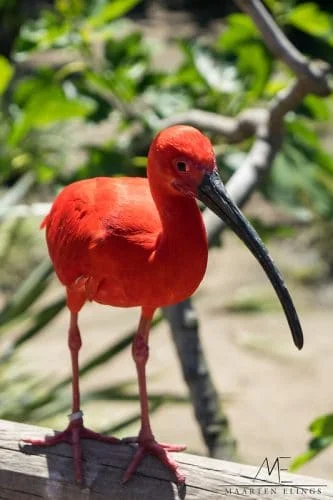
The scarlet ibis gets its name from the vibrant crimson of its feathers. They are medium-sized, brightly colored wading birds. Even though their feathers come in a rainbow of colors, only the tips of their wings are their signature hue.
The Scarlet Ibis and the American White Ibis are closely related to one another and are even often regarded as the same species.
They are carnivorous by nature, and scarlet ibises consume mostly insects as their primary food sources, particularly scarabs and ground beetles. In addition to it, they eat shrimp, mollusks, small crabs, and several other crustaceans.
You can find them in tropical wetlands, lagoons, and estuaries all the way from Florida to the Caribbean, and even into Venezuela and Brazil.
Even though scarlet ibises are protected in every part of the world, the number of these beautiful birds is decreasing because they are being shot too much, their eggs are being taken, and young birds are being bought to keep as pets.
7. American White Pelican
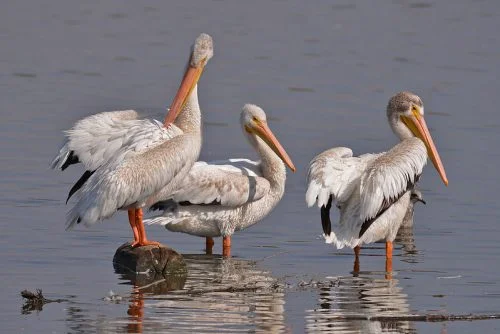
One of the largest birds native to North America, the American white pelican soars majestically on its wide, black-and-white wings. This bird appears ancient thanks to its massive head and a massive, hefty bill. The massive beak, which ranges from 11.3 to 15.2 inches in males and 10.3 to 14.2 inches in females, contributes to the bird’s overall length of roughly 50 to 70 inches.
The pelican has the largest beak of any bird, with enough space to hold three full buckets of fish.
The majority of what they eat is small fish, but they have also been seen eating crustaceans and amphibians. There are breeding colonies of American white pelicans in some parts of Canada and the northern United States, from Ontario to British Columbia and California to Minnesota. There have also been a few sightings in the south of Mexico and a few remote places along the central coast of Texas.
8. Black-headed Gull
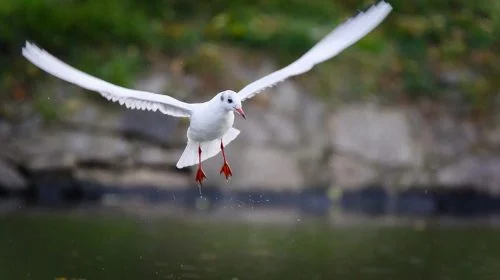
The black-headed gull is our most common small gull. During the summer months, an adult bird’s head is a rich chocolate brown (not black, though it can appear that way from afar), while the rest of its body is a drab grey, the primary flight feathers have black tips, and the beak and legs are bright red. The scientific name of this bird means “laughing gull.”
The black-headed gull is a scavenger and generalist that feeds on whatever is most conveniently available, be it insects, fish, worms, trash, or carrion in urban areas, or invertebrates in recently tilled fields. They supplement this with nuts and berries during the warmer months.
Many coastal regions of Europe, Asia, and eastern Canada are breeding grounds for black-headed gulls. Although most of these birds migrate to warmer climes in the south during the winter, a small group does spend the year in Europe’s far west. There are also black-headed gulls that spend the winter in the northwest parts of the United States and Canada.
To learn more about the Black-headed Gull you can visit: https://www.audubon.org/field-guide/bird/black-headed-gull
9. Black-necked Stilt
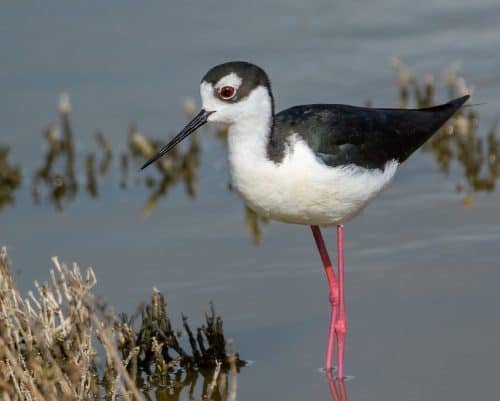
Black-necked Stilta is a small shorebird that has long legs, a long neck, a small head, and a narrow, straight bill. These birds have a black head and a white body, a white ring around each eye, and red legs. Women and juveniles often have a brownish tint to their black fur.
These birds feed on small seeds, flies, crayfish, brine shrimp, snails, tadpoles, and fish.
The Atlantic, Pacific, and Gulf coasts are all frequent locations for this widespread shorebird. Idaho, Kansas, and the Rocky Mountains are among the places it has been seen to wander inland. The black-necked stilt spends the colder months in southern Brazil, Peru, the West Indies, and along the southern coasts of the Pacific and Atlantic, and the warmer months in the Gulf of Mexico.
To keep potential enemies away from their young, these birds do elaborate aerial stunts and seem as if they have been injured. They are also able to swim for brief periods using only their wings, which is an incredible ability.
To learn more about the Black-necked Stilta you can visit: https://www.audubon.org/field-guide/bird/black-necked-stilt
10. Bonaparte’s Gull
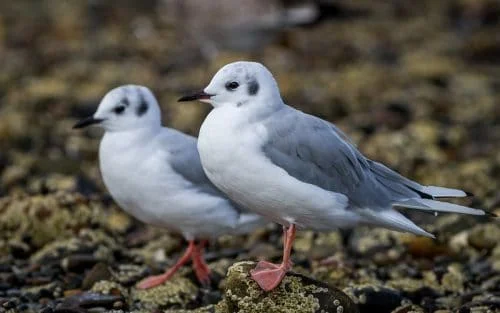
The Bonaparte’s gull is a member of the gull family Laridae, which is primarily found in northern North America. It is one of the smallest gull species, at about 28–38 cm in length.
The majority of its feathers are white, while the top half is dark gray. The hood of a Bonaparte’s gull is slate gray during the breeding season. Physically, people of both sexes look very similar.
They eat a wide variety of foods, and their preferred hunting prey changes both seasonally and annually. Bonaparte’s Gull relies primarily on insects throughout the breeding season.
Bonaparte’s Gulls can be spotted during migration and winter scavenging for small fish over ocean waters, lakes, rivers, and reservoirs, especially during periods of unstable or bad weather.
This is one of the tiniest gulls in North America, so keep an eye out for its diminutive stature and for the white wedges on its wings that indicate it is an adult. If you’re in the far north between May and July, look for spruce trees beside the water (especially on islands).
11. Red-legged Kittiwake
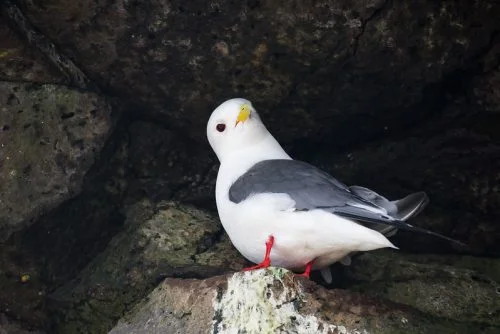
The red-legged kittiwake is a seabird species in the gull family Laridae. It has a shorter bill, larger eyes, a larger, rounder head, and darker gray wings in juveniles, which are virtually identical to adults. Adults are 14–15 inches long with a 33–36 inch wingspan and a body mass of 325–510 g.
The red-legged kittiwake eats a variety of fish and other marine organisms, including lanternfish, squid, and crustaceans. In the summer, it can be found nesting on the ledges of cliffs, and in the fall, it leaves for its wintering grounds in the northwestern Pacific Ocean and the Gulf of Alaska.
Locally common in its remote Beringean range. St. Paul Island, where it is present throughout the year, is the easiest spot to get a reliable population.
Dutch Harbor’s water is also present all year, albeit not as consistently. From fall to spring, it can be seen infrequently but regularly in the offshore seas south of the Kenai Peninsula and along the Alaska Peninsula.
To learn more about the Red-legged Kittiwake you can visit: https://www.audubon.org/field-guide/bird/red-legged-kittiwake
12. Snail Kite
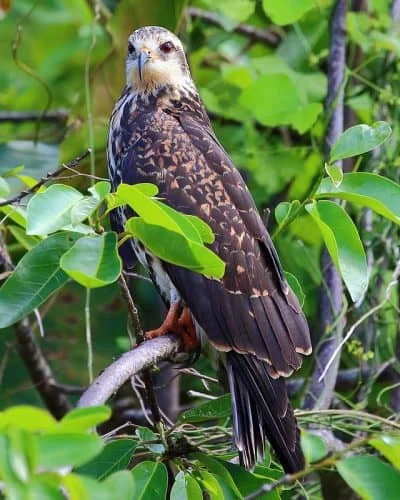
The Snail kite is a bird of prey that lives near bodies of water. The bird has a white rump and undertail coverts to complement its long, broad, and rounded wings. Due to its food, it has a black, deeply hooked beak. As an adult, the male has dark blue-gray plumage with darker flying feathers. The legs and cere are red.
True to its name, the Snail Kite feeds almost exclusively on freshwater snails. Although other raptors also have hooked bills, the Snail Kite has the most specialized bill of any raptor. Its sharp, pointy beak is used like a hook to pry open snail shells and retrieve the tasty treats inside.
The Snail Kites will consume the snails for their meat and then throw away the unharmed shells. This raptor has also been seen eating crabs, crayfish, rodents, and even a turtle, among other things.
You can find Snail kites in tropical areas of South America, the Caribbean, and central and southern Florida in the United States.
To learn more about the Snail Kite you can visit: https://www.audubon.org/field-guide/bird/snail-kite
13. White-tipped Dove
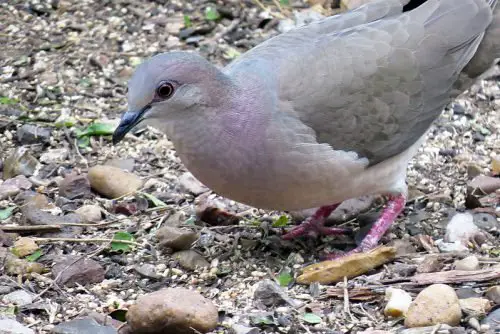
The White-tipped Dove is a large dove with a small head, a short, rounded tail, and short legs. Adults are brown on top and pale on the bottom, and their chins and foreheads are white. In flight, you can see that the corners of the tail are white. It has pale yellow eyes and red legs and feet. When the light is just right, the neck and breast look magenta and light blue-green.
Most of its food comes from seeds it finds on the ground, but it will also eat bugs like butterflies and moths.
The most common dove in the Americas is the White-tipped Dove. It is a quiet bird that usually lives on the ground in forests.
In the U.S., it only lives in the southernmost part of Texas, where it likes to hang out in the woods along the lower Rio Grande Valley.
To learn more about the White-tipped Dove you can visit: https://www.audubon.org/field-guide/bird/white-tipped-dove
14. Wood Thrush
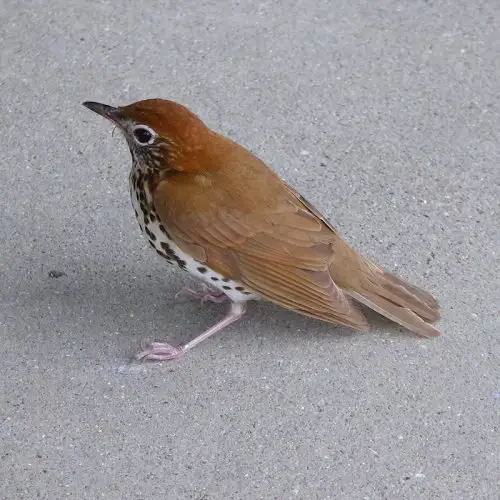
The wood thrush is a medium-sized thrush with brown feathers on top and white and brown spots on the bottom. Both the male and the female look the same. The breast and belly are white, and the breast, sides, and flanks have large dark brown spots.
It has red legs and white rings around its eyes.
Most of what they eat is insects and berries. feeds on beetles, caterpillars, ants, crickets, moths, and many other bugs, especially during the breeding season.
The Wood Thrush can breed from southern Canada to northern Florida and as far west as Nebraska and Oklahoma. Most of the time, it lives in old mixed deciduous forests.
The District of Columbia has adopted the Wood thrush as its state bird. It’s worth noting that the American robin is related to the Wood thrush. The male Wood Thrush has a unique repertoire of songs, and its ability to sing two notes at once gives its sound an ethereal, flute-like air.
To learn more about the Wood Thrush you can visit: https://www.audubon.org/field-guide/bird/wood-thrush
